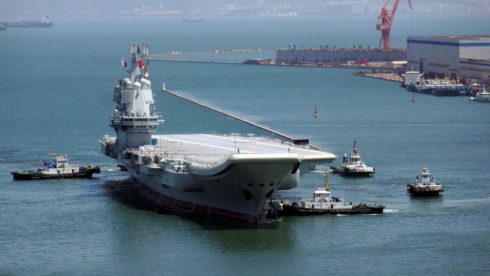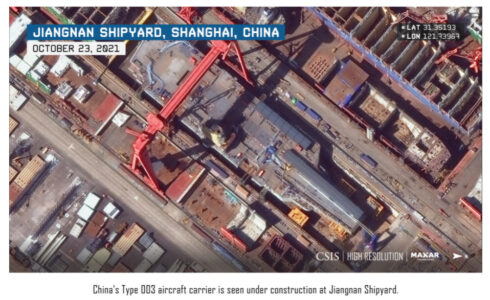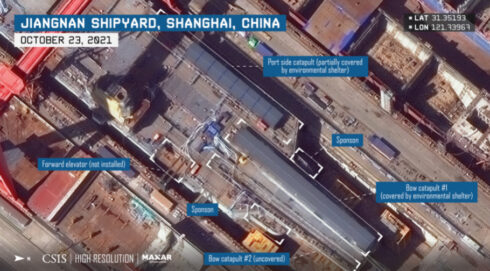
Prior file photo China’s first domestically developed aircraft carrier undergoing sea trials, in Liaoning Province, in May.
Originally published on ZeroHedge
China could be months away from launching its newest aircraft carrier, according to a new analysis by a Washington-based think tank.
The Center for Strategic and International Studies (CSIS) published commercial satellite imagery of China’s third aircraft carrier, commonly known as the Type 003, which will launch in three to six months. The images from Jiangnan Shipyard (captured on October 23) shows tremendous progress has been on the vessel:
The last several weeks witnessed a significant shift in the visual appearance of the Type 003. Sometime between September 18 and October 23, the two large openings in the vessel’s deck were sealed shut. These gaps allowed for large internal components, such as the engines and powerplants, to be inserted into the hull. Their closure suggests that the initial installation of major internal components has been completed. It is worth noting that the rear opening is not yet fully flush with the rest of the deck.
Other major components of the carrier are nearing completion, including the vessel’s catapults, which will assist with launching aircraft. One of the bow catapults remains covered by environmental shelters, indicating that workers are still installing and testing the system. The second bow catapult is not yet covered by environmental shelters, but it will be once installation and testing begin. Behind the two bow catapults, work is underway (underneath environmental shelters) on a third catapult on the ship’s port side.
The People’s Liberation Army Navy (PLAN), the world’s largest naval force, has only two aircraft carriers, the Liaoning and Shandong. The Liaoning was created using the hull of an older Soviet vessel, and the Shandong is a copy of the Liaoning with some improvements.
Type 003 is the most modern aircraft carrier China has designed to date. Offering a new Catapult Assisted Take-Off But Arrested Recovery (CATOBAR) will allow heavier aircraft with more payload and fuel to be launched. This could prove critical in defending its militarized islands in the South China Sea. When the new vessel enters service, CSIS said it would be a major addition for PLAN to project power in the Indo-Pacific region.
Naval domination is on the list for President Xi Jinping, who could be delivered a third presidential term next year, and likely remain in power for life. Xi has spent the better part of the last decade modernizing its military forces. The new carrier would give PLAN’s reach beyond the First Island Chain, including Taiwan, the Philippines, and Japan.
A 2020 Pentagon report estimated the carrier could enter service around 2023-2024. PLAN has an impressive force of approximately 355 ships and submarines, according to the DoD. The US Navy is smaller but has eleven nuclear-powered aircraft carriers and fielding stealth fighters. However, China is way ahead of the US in developing hypersonic weapons that could become aircraft carrier killers.
The great power competition between Bejing and Washington continues to heat up as Xi flexes his military might in the Indo-Pacific region. Both superpowers are falling into Thucydides Trap, a term used to explain when an emerging power threatens to displace an existing great power that usually result in war.






Nice but carriers are obsolete.
They should rather invest in jets, subs, cruise missiles and drones.
Yes, they need to invest more on Subs, ASW and heavy lift capabilities. As for drones, the Chinese have developed more drones than I can keep track of. They even rolled all them out on one airfield for the US satellites to see, including their rocket-powered one. Ditto for missiles.
355 ships? Bullshit. I bet the Pentagon is counting fish boats as well. IMO, the Type 003 carrier would likely take another year before it’s launched. Looking at how the Chinese are installing the catapults while in dry dock suggests they’ll be installing other systems while there.
Aircraft carriers are a product of the 20th centuries wars. They are nothing but giant, floating targets. They are very expensive to maintain and operate. Plus, you have all support ships, and crew just to keep the monstrosity supplied. Look at the U.S. Navy. and the massive logistics and supplies required to keep one CVN afloat and operational. Then you have all those ships that escort the thing. China has a long way to go, if they are trying to match a U.S. carrier battle group. Even now, the U.S. can only keep so many carriers out at sea, due to the costs, and the fact that F-18 fleet is very aged and in poor condition.